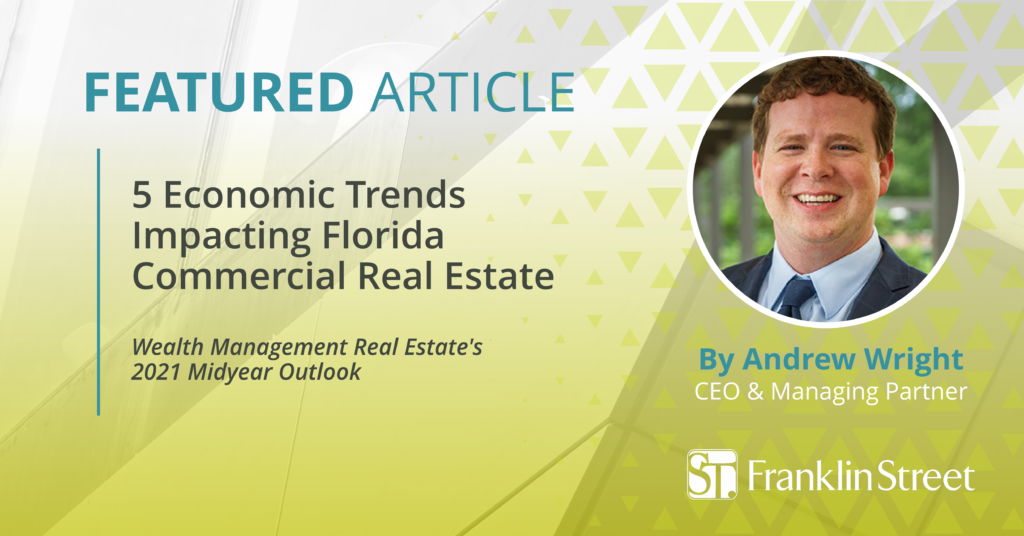By Andrew Wright, CEO & Managing Partner
Halfway through 2021, Florida has proven exceptionally resilient in the aftermath of COVID-19. Although the year began with some uncertainty, all signs now point toward a full recovery by the end of the year. Moving forward, we remain extremely bullish on Florida’s economy and commercial real estate market. Below, we examine five key trends shaping our market outlook:
1. Strong Population Growth and In-Migration
Florida remains one of the fastest-growing states, as residents from New York, New Jersey, California and other high-density regions relocate here for the better economic opportunity, lower cost of living and overall quality of life. The latest U.S. Census Bureau figures show Florida added more than 2.7 million residents from April 2010 to April 2020, bringing its population to 21,538,187 residents. This indicates a significant growth rate of 14.6%. More recent numbers from Federal Reserve Economic Data (FRED) clocked Florida’s population at 21,733,314 at the of 2020.
Notably, in-migration for career opportunities is driving much of this growth. A recent report from LinkedIn ranked Florida’s three largest metros among the top 10 markets its users are moving to for new jobs. Data from LinkedIn’s 740 million global users ranked Jacksonville as the top city for in-migration, followed by Miami-Ft. Lauderdale in 4th place and Tampa Bay in 7th place.
2. Extremely Competitive Housing Market
Florida is also experiencing an insatiable demand for homes. Single-family home sales in 2020 were up 5.8% year-over-year, with the median price increasing by 9.6% to $290,000, according to Florida Realtors. New construction homes are being absorbed as fast as they are built, while existing homes are often selling above the asking price within days of being listed.
Historic low interest rates, which dropped 70% last year, are also helping drive the demand. We can expect the Federal Reserve to promote an environment that keeps interest rates low for at least the remainder of 2021.
3. Rising Employment Rate
Florida’s unemployment rate at the end of May 2021 was 4.9%, nearly a full percentage point better than the national rate of 5.8%. The state’s unemployment has dramatically improved since the onset of the pandemic, which left 13.3% of the population unemployed at the end of May 2020.
4. Return to the In-Person Workplace
Fortunately for Florida, much of the fallout expected in the office market simply has not come to fruition. While vacancy rates are slightly above average in some markets, much of that is due to new construction that will be quickly absorbed. Tampa, for example, ended Q2 2021 at 7.6% vacancy, which is a less than 1% YOY increase. We also expected the amount of sublease space to increase over the last year, but most Florida markets have seen little change. The sublet vacancy rates in Miami, at 0.5%, as well as Tampa and Orlando, both at 0.9%, are healthy.
This data shows us that companies still see value in their office space. Anecdotally, most companies Franklin Street works with in Florida have now partially, if not fully, transitioned back to an in-person work setting.
5. Inflationary Environment
As the year goes on, we will be closely monitoring inflation and supply shortages occurring at a global level. The construction commodities market is experiencing extreme volatility, causing major swings in pricing and dragging out construction timelines.
The commercial insurance market is also experiencing significant rates increases and limited carrier options. While rates have begun to stabilize in some markets, we do not yet know how risk factors such as COVID-19 and increasing hurricane activity will impact premiums in Florida.
In both cases, flexibility and having the right partner to help you navigate these unpredictable markets are key.
This article was originally published in Wealth Management Real Estate’s 2021 Midyear Outlook. Read the full publication here.





